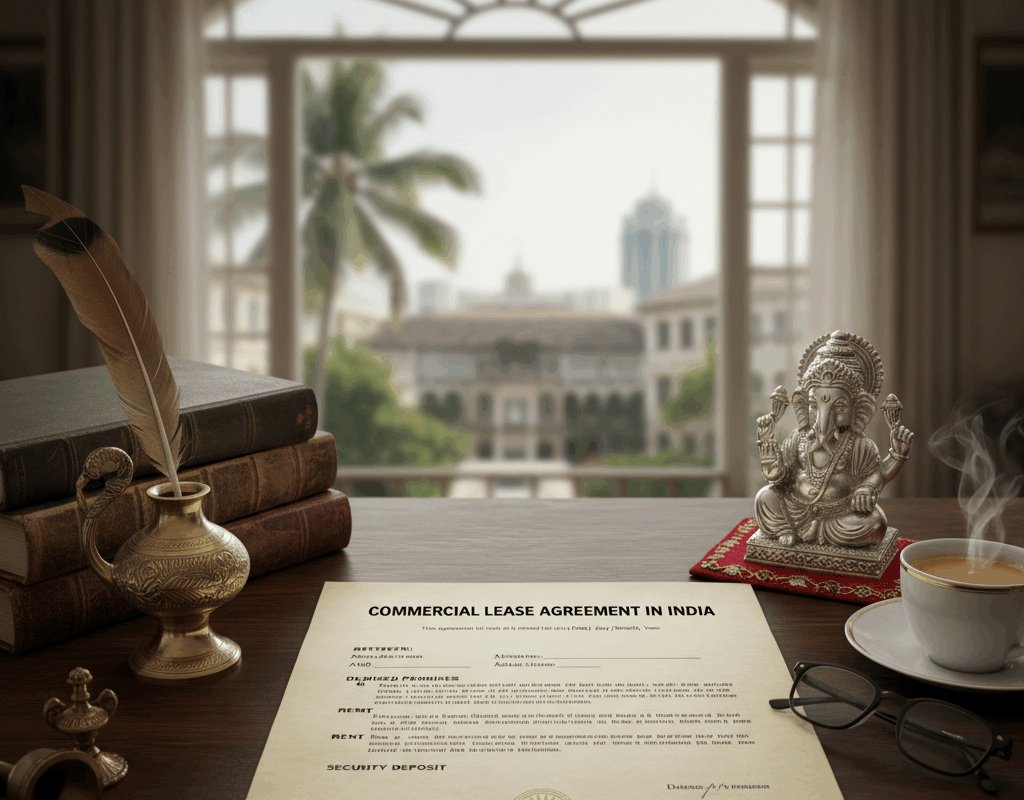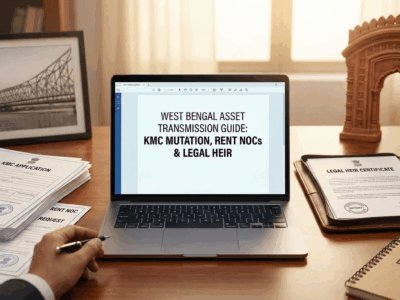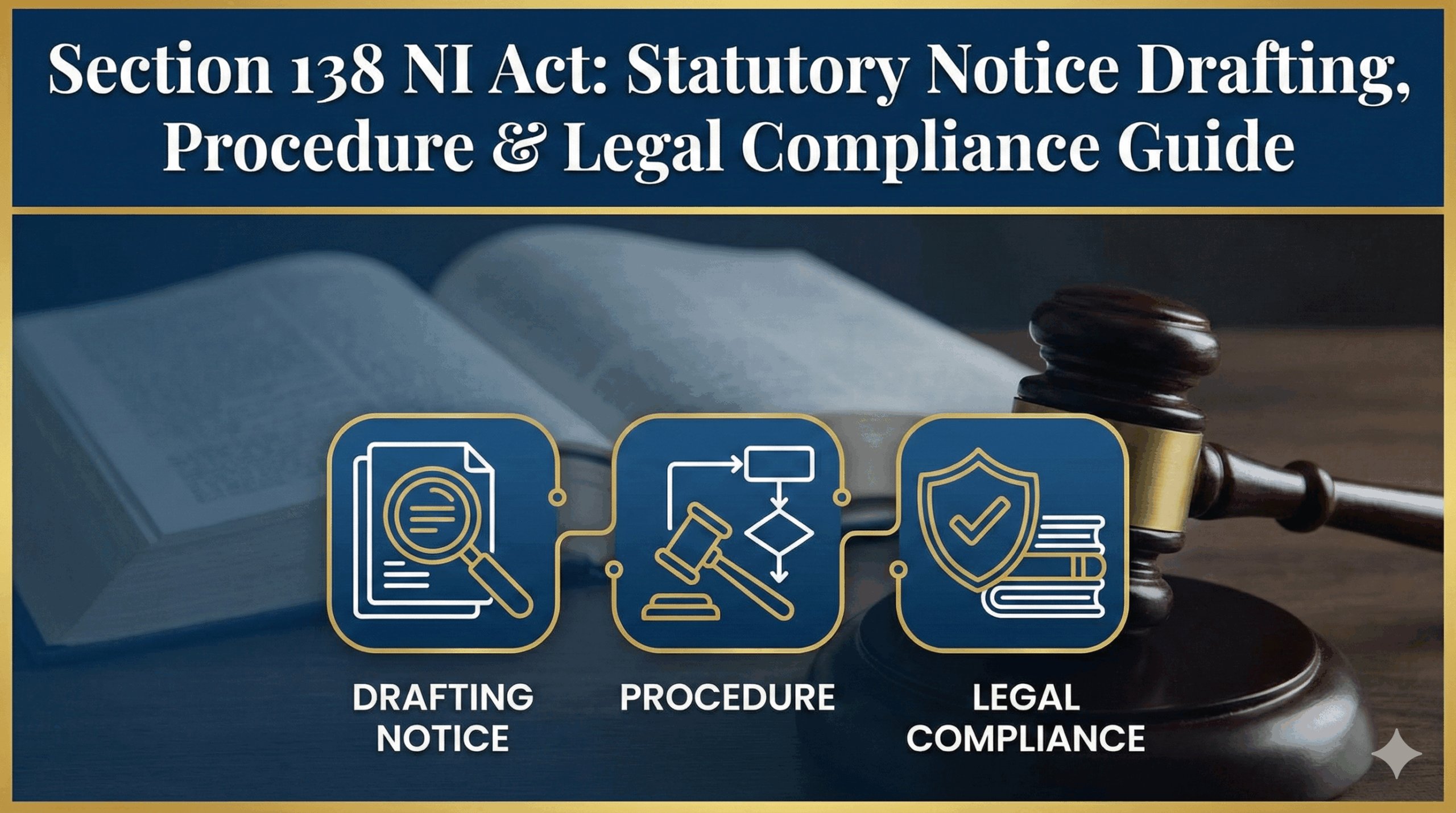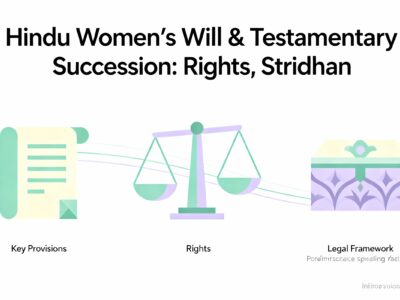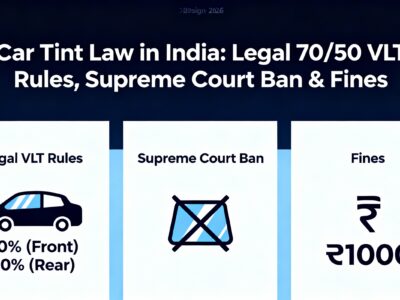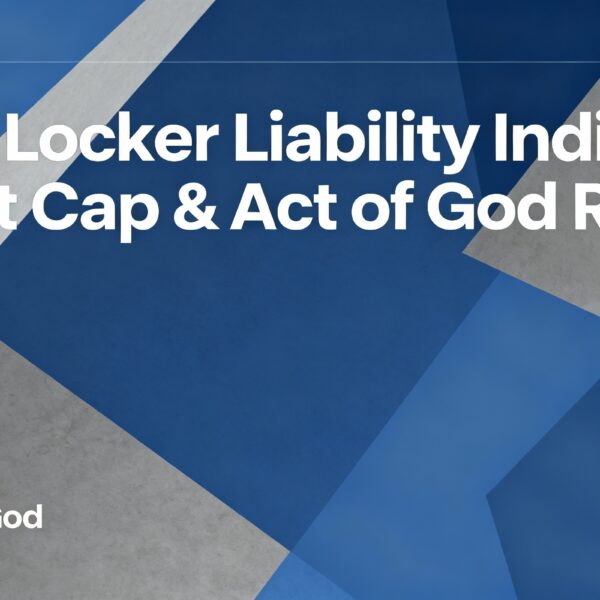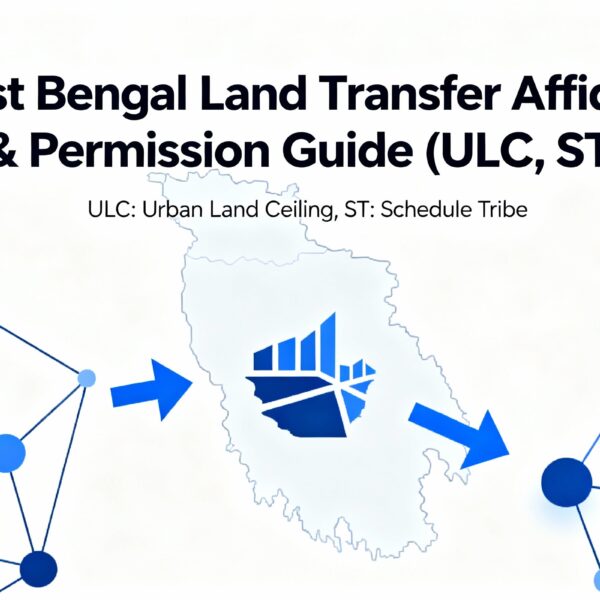Drafting a legally sound commercial lease agreement is a critical step in protecting the rights of both landlords and tenants across India. This process, often complex and time-consuming, is now simplified with Evaakil.com’s interactive drafting tool.
By entering key details about the parties, property, and financial terms below, you can instantly generate a structured, preliminary draft of your rent agreement. This tool provides a solid foundation for your legal document, saving you time and helping to ensure all essential clauses are considered from the start.
A Comprehensive Guide to Drafting Commercial Lease Agreements in India
Legal Principles, Commercial Strategies, and Modern Practices | Updated: September 2025
Section 0: Pre-Lease Due Diligence: Your Essential Checklist
Before the first word of a lease is drafted, a thorough due diligence process is non-negotiable. This proactive investigation safeguards your investment and prevents costly surprises down the line. It's about verifying claims, understanding limitations, and ensuring the property is legally and commercially viable for your intended purpose.
The Tenant's Due Diligence Checklist
Title & Ownership Verification
Confirm the landlord's legal right to lease the property. Request and verify the chain of title deeds from the local Sub-Registrar's office.
Building Approvals & Compliance
Verify the Occupancy Certificate (OC) and Completion Certificate (CC) issued by municipal authorities. An absence of these can lead to legal complications, including demolition orders.
Encumbrance Certificate (EC)
Obtain an EC for the last 15-30 years. This document reveals if there are any existing mortgages, liens, or legal disputes attached to the property that could impact your tenancy.
Zoning & Land Use Permissions
Ensure the local master plan permits your specific commercial activity (e.g., retail, restaurant, office) at the property's location. A mismatch can result in a forced shutdown by authorities.
Section 1: The Legal & Regulatory Superstructure
The legal framework governing commercial leases in India is a complex, multi-layered environment. It is a fragmented tapestry woven from central statutes that provide the foundational principles and state-specific laws that introduce significant jurisdictional variations. Understanding this interplay is the essential first step for any entity involved in commercial real estate.
India's Commercial Leasing Legal Hierarchy
Modern Regulations
RERA, GST, TDS
State-Specific Statutes
Rent Control Acts, Shops & Establishment Acts
Foundational Central Legislation
Transfer of Property Act, Contract Act, Registration Act, Stamp Act
1.1. Foundational Central Legislation: The Bedrock
The Transfer of Property Act, 1882 (TOPA)
TOPA is the principal statute, defining a "lease" (Section 105), mandating registration for leases over one year (Section 107), and outlining default rights and liabilities for landlords and tenants (Section 108).
The Indian Contract Act, 1872
Every lease is a contract. It must have lawful consideration, competent parties, free consent, and a lawful object to be enforceable.
The Registration Act, 1908 & The Indian Stamp Act, 1899
These acts are procedural pillars. A lease for over a year must be registered (Section 17, Registration Act). Before registration, it must be properly stamped. An unregistered or under-stamped lease is inadmissible as evidence in court, making it practically unenforceable.
1.2. State-Specific Statutes: The Layer of Complexity
Rent Control Acts
While most modern commercial leases are structured to fall outside the purview of archaic Rent Control laws (often by setting rents above a statutory threshold), their existence must be acknowledged and legally navigated.
Shops and Establishment Acts
These state-level laws govern the operational aspects of a commercial establishment, such as working hours, holidays, and employment conditions. The lease should not contain any clauses (e.g., mandating 24/7 operation) that would violate the local S&E Act, as this would render the clause unenforceable.
Section 2: Anatomy of a Commercial Lease Agreement
A well-drafted lease is a dynamic risk management tool. It requires precision, clarity, and the strategic allocation of rights, responsibilities, and risks to prevent future conflicts.
Anatomy of a Commercial Lease
2.2. In-Depth Analysis of Essential Clauses
Lease Term & Renewal
Specifies duration (typically 3-9 years) and must clearly state commencement and termination dates. The Renewal Option is vital, detailing the notice period and the mechanism for revised rent calculation.
Maintenance and Repairs
A frequent source of disputes. The lease must clearly delineate responsibilities: Lessee for internal/non-structural upkeep, and Lessor for major structural repairs and common area maintenance.
Interactive Chart: Lease Cost Allocation
Compare who pays for what in different lease types. A Triple Net (NNN) lease shifts most operating expenses to the tenant, resulting in lower base rent.
Table 1: Comparative Analysis of Lease Types
| Feature | Gross Lease | Modified Gross Lease | Triple Net (NNN) Lease |
|---|---|---|---|
| Base Rent | Higher | Moderate | Lower |
| Property Taxes | Landlord | Shared/Negotiable | Tenant |
| Property Insurance | Landlord | Shared/Negotiable | Tenant |
| Common Area Maintenance (CAM) | Landlord | Shared/Negotiable | Tenant |
| Structural Repairs | Landlord | Landlord | Tenant |
Section 3: Property-Specific Drafting Considerations
Drafting varies dramatically depending on the property type. A standalone showroom offers autonomy, while a mall unit offers access to a managed commercial ecosystem. A robust lease anticipates the unique operational realities of the specific property.
Standalone Showroom vs. Mall Unit: Key Differences
Standalone / High-Street
✅ Signage Freedom
High brand visibility, subject to municipal approval.
✅ Operational Autonomy
Flexible operating hours, direct control.
❌ Higher Responsibility
Tenant often responsible for all maintenance, including structural (NNN lease).
Shopping Mall Unit
❌ Restricted Signage
Must adhere to strict mall signage manual.
❌ Mandatory Hours
Must operate during mall hours, with penalties for non-compliance.
✅ Managed Ecosystem
Landlord manages common areas (CAM charges apply), security, and marketing.
3.1. Office Spaces
Leases for corporate offices in commercial buildings have their own set of critical clauses:
- Fit-Out Period: A rent-free period (typically 30-90 days) granted to the tenant to furnish the premises. The lease must specify the duration and the scope of work allowed.
- Service Level Agreements (SLAs): For Grade-A buildings, the lease should incorporate SLAs for building services like HVAC uptime, elevator availability, and security response times, with penalties for non-compliance.
- Parking Rights: The number of reserved parking spots is a key commercial term. The clause should specify the location and any associated charges.
3.2. Industrial & Warehousing Units
The logistics and manufacturing sectors rely on highly specific lease terms:
- Floor Load Capacity: The lease must warrant the floor's capacity (e.g., 5-10 tons per sq. meter) to support heavy machinery or inventory.
- Access and Docking Bays: Clauses must guarantee 24/7 access for trucks and specify the number of exclusive or shared loading/unloading docks.
- Statutory Compliances: The lease should clarify responsibility for obtaining specific industrial licenses, such as those from the Fire Department or Pollution Control Board.
Section 4: Revenue Share Models & Modern Financial Clauses
Particularly in the retail sector, lease agreements are evolving from simple fixed-rent models to more complex arrangements that align the interests of both the landlord and the tenant. Understanding these structures is vital for mall establishments and high-street retail.
4.1. The Rise of Revenue Sharing
This model combines a fixed "Minimum Guarantee" (MG) rent with a "Percentage Rent" component, where the landlord receives a share of the tenant's turnover above a certain threshold. This creates a partnership where the landlord is incentivized to increase footfall and create a thriving commercial environment.
How Revenue Share Rent Works
The tenant pays the higher of two amounts: the fixed Minimum Guarantee (MG) or a pre-agreed percentage of their monthly turnover.
Minimum Guarantee (MG)
₹1,00,000
A fixed monthly rent, providing a stable income for the landlord.
Percentage Rent
8% of Turnover
Aligns landlord's income with tenant's success.
Example Scenario:
If monthly turnover is ₹20,00,000, the percentage rent is ₹1,60,000 (8% of 20L). Since this is higher than the MG of ₹1,00,000, the tenant pays ₹1,60,000.
4.2. Drafting for Revenue Share
Key drafting points for such clauses include:
- Defining "Turnover": The clause must be precise. Does it include GST? What about online sales fulfilled from the store? Are returns and discounts excluded?
- Audit Rights: The landlord must have the right to audit the tenant's books to verify the reported turnover. The clause should specify the audit process and who bears the cost.
- Reporting Mechanism: The lease must mandate the tenant to provide a certified monthly sales report by a specific date.
Section 5: Execution and Enforcement
A perfectly drafted lease is worthless if not executed correctly. Due diligence, stamping, and registration are non-negotiable steps that give the lease its legal teeth.
The 3-Step Lease Execution Process
Due Diligence
Verify landlord's title, building approvals (Occupancy Certificate), and zoning compliance.
Stamping
Pay the requisite stamp duty (varies by state) via e-stamping or physical stamp paper. Under-stamping makes the lease inadmissible in court.
Registration
Mandatory for leases over 1 year. Both parties and witnesses must appear before the Sub-Registrar. An unregistered lease is legally invalid for proving the term.
5.2. Navigating Stamp Duty
Stamp duty is a state-level tax, and its calculation varies significantly. Below is a comparative look at indicative rates in key states, along with an interactive chart to visualize the differences.
State-wise Stamp Duty on Commercial Leases
| State | Lease Term | Illustrative Stamp Duty Rate |
|---|
Interactive Chart: Stamp Duty Comparison (Up to 5 Years)
This chart visualizes the stamp duty as a percentage of the average annual rent for a lease term up to 5 years. Hover over the bars for exact values.
Section 6: Termination, Disputes, and Exit Strategies
Even the most meticulously drafted lease can face disputes. A strong agreement anticipates potential conflicts and prescribes clear, efficient mechanisms for resolution and termination. A well-defined exit strategy is as important as the entry plan.
6.1. Grounds for Termination
The lease must explicitly list the events that trigger a right to terminate. Common grounds include:
- Monetary Breach: Failure to pay rent or other dues for a specified period (e.g., 2-3 consecutive months).
- Non-Monetary Breach: Violation of a material clause, such as unauthorized alterations, subletting without consent, or using the premises for illegal activities.
- Insolvency: If the tenant company undergoes liquidation or bankruptcy proceedings.
- Force Majeure: If a force majeure event continues for an extended period (e.g., over 180 days), making operations impossible.
6.2. Dispute Resolution Mechanism
Choosing the right forum for dispute resolution can save significant time and money. The two primary options in India are litigation and arbitration. The lease must specify the chosen method and the jurisdiction (e.g., "Courts in Mumbai shall have exclusive jurisdiction").
Commercial Lease Dispute Resolution Pathway
6.3. The "Lock-In" Period: A Double-Edged Sword
The lock-in period is a duration during which neither party can terminate the lease. For landlords, it ensures a stable rental income. For tenants, it guarantees business continuity. However, its enforceability can be contentious. Indian courts have held that a landlord can claim rent for the remainder of the lock-in period as reasonable damages if a tenant vacates prematurely, provided the landlord demonstrates efforts to mitigate losses by finding a new tenant.
Section 7: The Evolving Landscape (Post-2022 Trends)
The commercial real estate landscape is in constant flux, influenced by global events, technological advancements, and a growing emphasis on sustainability. Modern lease agreements must reflect these new realities.
7.1. The Post-Pandemic Force Majeure Clause
Historically a boilerplate clause, "Force Majeure" came under intense scrutiny during the COVID-19 pandemic. Modern drafting now explicitly includes "epidemics," "pandemics," and government-mandated lockdowns as force majeure events, detailing the consequences, such as rent suspension or abatement, rather than leaving it ambiguous.
7.2. Rise of Flexible and "Green" Leases
Businesses increasingly demand flexibility. This has led to:
- Shorter Lease Terms: A shift from 9-year terms to 3-5 year terms is becoming more common.
- Break Clauses: Options for the tenant to terminate the lease early, often after the lock-in period, subject to a penalty.
- Green Lease Clauses: Provisions that mandate cooperation between landlord and tenant to improve the building's environmental performance, covering energy efficiency, waste management, and water conservation.
Section 8: Advanced Commercial Clauses & Financial Nuances
Beyond the standard framework, several advanced clauses and financial considerations can significantly impact the rights and obligations of both parties. Mastering these nuances separates a basic lease from a strategic one.
8.1. The Security Deposit: More Than Just Security
The security deposit is typically equivalent to 3-6 months of rent. Key drafting points include:
- Interest-Bearing vs. Non-Interest-Bearing: This is a major point of negotiation. The lease must clearly state whether the landlord is liable to pay interest on the deposit amount upon refund.
- TDS on Rent: As per Section 194-I of the Income Tax Act, if the annual rent exceeds ₹2,40,000, the tenant is required to deduct TDS (Tax Deducted at Source) at 10% from the monthly rent payments. The lease should obligate the tenant to provide TDS certificates to the landlord.
- Refund Timeline: Specify a clear timeline for the refund of the deposit after the lease termination (e.g., "within 30 days of handing over vacant possession"), and list permissible deductions (e.g., for damages beyond normal wear and tear, pending utility bills).
8.2. Assignment vs. Subletting: A Critical Distinction
These terms are often used interchangeably but have distinct legal meanings. A lease should explicitly state whether these are permitted, and under what conditions (e.g., with prior written consent of the landlord).
| Concept | Description | Original Tenant's Liability |
|---|---|---|
| Assignment | The entire leasehold interest is transferred to a new tenant (the "Assignee"). | Generally ceases, as the assignee steps into their shoes. |
| Subletting (or Sub-leasing) | A part of the premises or a part of the lease term is transferred to a new tenant (the "Sub-lessee"). | Remains fully liable to the landlord for all lease obligations. |
8.3. The "Exclusivity" Clause: Protecting Your Niche
For tenants in a shopping mall or retail complex, an exclusivity clause can be invaluable. This provision prevents the landlord from leasing space to another tenant who would be a direct competitor. For example, a high-end coffee shop could negotiate a clause preventing the mall from leasing to another "specialty coffee" brand. This must be drafted carefully to define the scope of the competing business precisely.
Commercial Lease Drafting Tool
Generated Lease Draft
Your draft will appear here as you fill the form...
Disclaimer: This is an auto-generated draft for informational purposes only and does not constitute legal advice. It is essential to consult a qualified legal professional for finalization.
Conclusion
A successful commercial lease in the contemporary Indian market is one that is not only legally robust and commercially sound but also procedurally flawless and strategically managed. It requires a holistic approach that balances the protection of legal rights with the achievement of business objectives, navigating the complexities of Indian law while embracing the efficiencies of modern technology.

